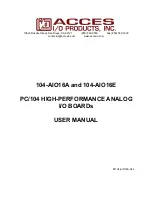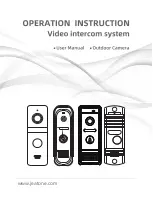
Manual 104-AIO16A and 104-AIO16E
5
Chapter 1: Introduction
This PC/104 based Data Acquisition Module is an ideal solution for embedded applications requiring high-
resolution and high-speed analog input, analog output, and digital I/O capabilities. This manual applies to
both the “16A” version and the “16E” version, with the primary difference being the achievable sampling
speed. Wherever a reference is made to a sampling frequency or clock frequency, 500k applies only to
the “16A” version, while 250k applies only to the “16E” version.
Features
z
16-bit resolution A/D
z
Sampling rate
“16A” version: 500ksamples/sec (maximum aggregate)
“16E” version: 250ksamples/sec (maximum aggregate)
z
16 single-ended or 8 differential analog inputs
z
Channel-by-channel ranges of 0-1V, 0-2V, 0-5V, 0-10V, ±1V, ±2V, ±5V, ±10V
z
A/D Start sources: Software, Timer, and External Trigger (rising or falling edge; software
selectable)
z
A/D Modes: Single Channel or Scan
z
Offset / Gain Error Calibration
z
Noise reduction with Channel Oversampling
z
Over-voltage protection of -40V to +55V
z
First In First Out (FIFO) A/D buffer
z
Two 12-bit Digital-to-Analog (DAC) outputs
z
DAC error calibration
z
16 high-current Digital I/O lines
z
16-bit programmable counter/timer
z
PC/104 module size and mounting compatibility
Applications
z
Equipment monitoring
z
Environmental measurements
z
Embedded data acquisition
z
Education/Laboratory
Functional Description
This product is a PC/104-based Analog to Digital converter board with 16 single-ended or 8 differential
analog inputs. The board is capable of sampling speeds up to 500kHz. Analog input channels are
enabled as a consecutive set by software. Each channel within the set is independently configured by
software to accept one of ten different analog input ranges.
Analog to digital conversion starts or “A/D starts” are issued one of three ways: Software Start, Timer
Start, or External Trigger Start. A/D starts are software configured to be either rising or falling edge.
Additionally, A/D starts are software configured to be Single Channel or Scan. Single Channel samples
data once from the next consecutive channel within the enabled set. A Scan samples data from all
channels within the set at the fastest possible rate. An onboard FIFO allows the analog data to be
buffered and read out at a later time. The FIFO has two flags, FIFO half-full and FIFO full, which can both
trigger an IRQ.
Two 12-bit DAC outputs are provided. Output ranges of 0-5V and 0-10V are field selectable with jumpers,
per output.
Also provided are 16 Digital I/O lines in 2 groups of 8 lines. Both Digital I/O bytes are individually
software selectable as input or output.






































